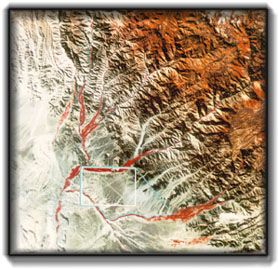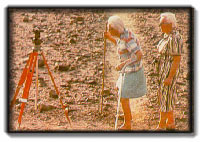History
From a stylistic point of view, one can
distinguish three large complexes in the concentration of lines
and geoglyphs. The
first is known as Chavin (500-300 B.C.) and it is represented by
a figure constructed by the piling up of stones. It depicts a large bird with its
wings extended - ready to fly.  This era was very important in the cultural development of the Andes. Apart from the
geoglyph mentioned we also have the famous printed cloth of the Karwas. In both cases there is
clear evidence of the strong Northern influence of the Late-Middle Formative Period in
the Ica zone.
This era was very important in the cultural development of the Andes. Apart from the
geoglyph mentioned we also have the famous printed cloth of the Karwas. In both cases there is
clear evidence of the strong Northern influence of the Late-Middle Formative Period in
the Ica zone.
The second complex corresponds to the
development known as Paracas (400 B.C. - 200 A.D.). Which began with a strong influence from the
Northern cultures who were expanding. Paracas was a community
which adapted its
economy to a difficult and arid environment, developing highly
advanced artistry as noted in the exquisite cloth and embroideries, which were part of the
Paracas-Nasca tradition, renowned through out the world. This complex has a number
of important representations of stylised cats and anthropormophic
figures with
sophisticated hair pieces, carrying canes and head trophies as
well as knives in their hands. Most of them are to be found in the low-lying slopes of the
hills.
Most of the figures represented in the third
complex are particular to the Nasca culture (200 B.C. - 500 A.D.). Nasca is one of the
communities which characterises the great diversities of cultures
developed over time
in the Central Andes. They established a successful economy in a
difficult area due to its dryness and mountainous geography - based on the Paracas cultural
development. All of this was accompanied by a huge mystical-religious system
particular to the Andean region. Together with the Moche people
of the Northern coast
of Peru they were known for their exceptional handicrafts,
particularly evident in their pottery as well as their textiles.
Most of the geoglyphs were made by sweeping the
pebbles from the surface to form lines and to define areas. The lines form huge
naturalistic schematic figures, such as monkeys, spiders, plants,
hummingbirds, pelicans
and other types of birds, as well as complex geometric designs
like spirals and broken or very long unbroken lines. The defined areas contain huge
rectangular and trapezoidal figures and these, together with the lines, create fascinating
sets of monumental proportions. Many of these are found near to
populated areas of
that time, as in the case of Quebada del Fraile, Cahuachi and
other less important sites as in Palpa and Ingenio.
These large geoglyphs are not only found in
concentrations but are also found dispersed over a  larger area which include the river basins of
Santa Cruz, Rio Grande, Palpa, Ingenio and Nasca.
larger area which include the river basins of
Santa Cruz, Rio Grande, Palpa, Ingenio and Nasca.
National interest in the geoglyphes began in
1939 with the 27th Congress of Americanists. At this event Mejia Xeespe introduced various
theories about their origin and use, where the deep
mystical-religious system had to have an important role in their conception and
construction.
Foreing researchers have also tried to discover
their origin and function, including Paul Kosok, who since 1941 has been interested in this
problem. Through him, Maria Reiche, a German, became fascinated
with the lines and
since this time has carried out significant work; as much in
conservation as in investigation. She has made complex mathematical calculations to deduce how
the figures were conceived and created.
 This era was very important in the cultural development of the Andes. Apart from the
geoglyph mentioned we also have the famous printed cloth of the Karwas. In both cases there is
clear evidence of the strong Northern influence of the Late-Middle Formative Period in
the Ica zone.
This era was very important in the cultural development of the Andes. Apart from the
geoglyph mentioned we also have the famous printed cloth of the Karwas. In both cases there is
clear evidence of the strong Northern influence of the Late-Middle Formative Period in
the Ica zone. larger area which include the river basins of
Santa Cruz, Rio Grande, Palpa, Ingenio and Nasca.
larger area which include the river basins of
Santa Cruz, Rio Grande, Palpa, Ingenio and Nasca.